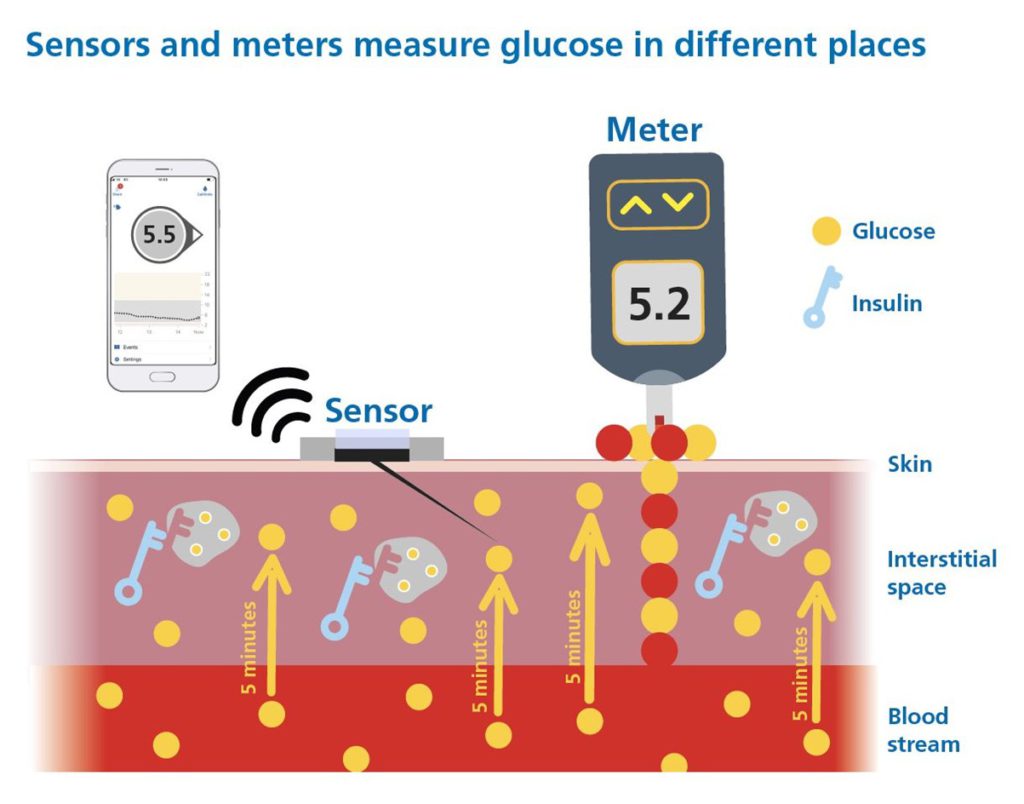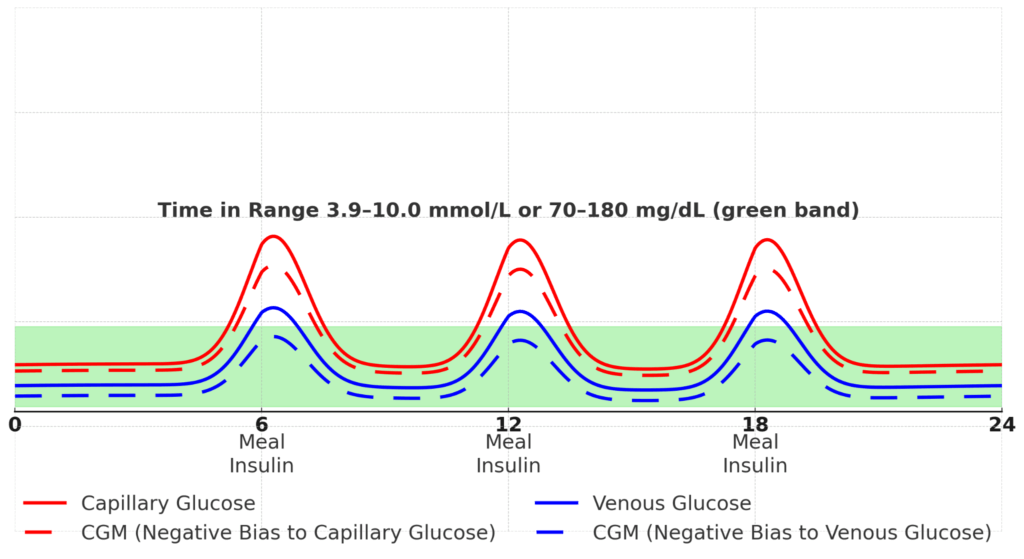Prefer a podcast series?
Listen to the CGM 3-Part Series.
If you prefer reading, welcome to the thing that has consumed six years of my life.
Start here: CGM Systems Guide – Part 1
Before we get into which CGM to pick, it is crucial to understand that different CGM systems are calibrated differently and do not all measure glucose on the same “scale”.
Some CGMs sit between capillary and venous glucose and reflect true physiological exposure. Others sit below venous glucose and systematically under-report real glucose levels. If a device under-reads, you may need 5–10% higher Time in Range (TIR) targets to achieve the same outcomes as systems that report true exposure.
That calibration difference is non-trivial. It directly affects what “70% TIR” actually means in the real world.
For this reason, everything in this CGM selection guide assumes you have already understood the foundations in:
CGM Systems Guide – Part 1: Regulation, Calibration, and Why Some CGMs Need 5–10% Higher TIR Targets
If you have not read Part 1 yet, pause here and read it first. It explains why different CGMs may need different TIR goals before we start comparing systems and study designs.
What is Continuous Glucose Monitoring (CGM)?
A Continuous Glucose Monitor (CGM) is a wearable device that tracks glucose levels day and night, providing real-time readings, trend arrows, and alerts for high and low glucose. CGMs are now central to diabetes management, giving insight far beyond traditional finger-prick blood glucose monitoring.
The picture below shows how CGM works and how trend arrows let you “see into the future” of your glucose levels.
For the basics, start with CGM Foundations — how continuous glucose monitoring can guide bolus insulin decisions — and then explore the GAME-SET-MATCH framework for dynamic glucose management strategies.

However, not all CGMs are created equal, and choosing the right one requires far more than comparing headline accuracy numbers and app features.
Adjunctive vs non-adjunctive CGM – why it matters
CGM systems fall into two broad categories:
- Adjunctive CGM – requires confirmation with finger-prick blood glucose (SMBG) before insulin dosing and hypoglycaemia treatment.
- Non-adjunctive CGM – approved for insulin dosing decisions and hypoglycaemia treatment without mandatory finger-prick checks.
This guide focuses only on systems with non-adjunctive approval.
When we are using CGM for insulin dosing and hypo treatment, risk assessment comes first — then performance.
Why risk assessment comes first
Before comparing CGMs based on performance metrics, we need to understand the risk profile of each device.
Think of it like scouting a football player:
If I claimed I had scored as many goals as Messi and Ronaldo, but cost half the price, should you sign me immediately?
Or would you first ask:
- Where did you score those goals? (Top leagues or Sunday league?)
- How competitive were the matches? (Training games or real fixtures?)
- How do you perform at the highest level, under real pressure?

A CGM might advertise a Mean Absolute Relative Difference (MARD) of 10%, suggesting that, on average, readings are only 10% away from a comparator value.
But unless we know how, where, and against what it was tested, those numbers are close to meaningless.
Without robust testing, choosing a CGM is like buying a car that has only ever been driven at the speed limit in the middle lane on an empty motorway.
In real life, people use all three lanes and change lanes rapidly — just as glucose levels fluctuate in real life.
Would you drive a car that had only been tested like this?

Five key questions for CGM accuracy studies
To meaningfully compare CGM systems, we have to look at how their accuracy was tested. The POCT05 guideline, the eCGM clinician consensus, and the IFCC Working Group for CGM outline five critical questions for CGMs used for insulin dosing.
The answers tell us whether the CGM has been tested across the full glucose range (typically 2.2–22.2 mmol/L or 40–400 mg/dL) and at the rates of change that occur in daily life.
Q1. Has the data been peer-reviewed or reviewed by the FDA?
High-quality CGM evaluations are reviewed either by:
- Reputable diabetes technology journals, and/or
- Regulators such as the FDA.
That scrutiny covers study design, participant selection, test procedures, and outcomes. It reduces bias and allows clinicians, people with diabetes, and regulators to critique the evidence themselves.
We need this level of confidence when we are making decisions about a drug (insulin) that carries one of the highest risks of any prescribed medicine.
Q2. What percentage of study participants had type 1 diabetes?
If fewer than roughly 70% of participants had type 1 diabetes, the CGM may not have been stress-tested under the rapid glucose swings commonly seen with T1D.
People with type 1 have little or no endogenous insulin. Their glucose can move quickly and dramatically, which is exactly when we most need CGM accuracy.
Q3. Were meal and insulin challenges performed?
A robust accuracy study should deliberately trigger high and low glucose episodes.
- Food without insulin → rapid glucose spikes.
- Too much insulin without food → fast drops and hypoglycaemia (“rage bolus” territory).
Without these challenges, the CGM may never be tested in the very scenarios where accuracy matters most.
Q4. What percentage of comparison readings were < 4.4 mmol/L (80 mg/dL)?
At least 8% of paired CGM vs comparator readings should be below 4.4 mmol/L (80 mg/dL), as per Performance Metrics for Continuous Interstitial Glucose Monitoring (POCT05).
No one is aiming for 8% hypoglycaemia in real life. This threshold simply ensures enough data in the low range to meaningfully assess performance.
Q5. What percentage of comparison readings were > 16.7 mmol/L (300 mg/dL)?
At least 5% of paired readings should exceed 16.7 mmol/L (300 mg/dL), to adequately test performance in the very high range.
If these extremes are not well represented, the CGM’s ability to reliably detect dangerous highs and lows is unknown. That uncertainty is not acceptable when we are using readings to treat hypos or to deliver large correction doses.
I will deliberately repeat this:
Insulin carries one of the highest risks of any prescribed drug.
Which CGMs have been tested robustly for insulin dosing?
I have co-developed CGM comparison charts with the Diabetes Specialist Nurse (DSN) Forum UK. The most up-to-date version is hosted on their website.

The first chart uses the five study-design questions above to identify which CGM devices have been tested using methods that meet basic international standards.
It provides an overview of CGM systems currently available in the UK and Europe and gives each device a study design score out of 5.

Using these five questions is the equivalent of identifying which cars have been tested in all three lanes at different speeds, and which have only ever cruised steadily in the middle lane.

Any CGM system with a study design score < 4 does not provide enough evidence to understand its accuracy, or the risk of readings in the low and very high glucose ranges — exactly where clinical and insulin dosing decisions are made.
This remains true even if a CGM system has a CE mark for non-adjunctive use across a wide age range.
More recently, CE marking for CGMs used to drive automated insulin delivery (AID), without peer-reviewed published data, has triggered serious concerns. These have been highlighted by paediatric endocrine societies and adult diabetes technology networks.
Why is this concerning? Because we lack solid data on CGM performance when glucose is in the low and very high ranges. This does not mean those CGMs are unsafe; it means we do not know the risk.
From this point forward, I focus on CGM systems that meet both of the following:
- Study design score of 4 or higher, and
- Non-adjunctive approval for insulin dosing and hypoglycaemia treatment.
You may reasonably ask why adjunctive CGM systems — especially those with a study design score below 4 — are still available on prescription, given that people eligible for CGM under NICE guidance (NG17, NG18, NG28, TA943) are all using insulin.
It certainly makes me scratch my head.
The CGM devices with robust study design (score ≥ 4) and non-adjunctive approval are:
- Accu-Chek SmartGuide
- Dexcom G6 and Dexcom One
- Dexcom G7 and Dexcom One+
- FreeStyle Libre 2 and Libre 3 Plus
- Medtronic Guardian 4
- Medtronic Simplera
What should CGM readings be compared against?
Once we know which CGMs have robust study designs, the next step is understanding what “truth” they are being compared to.
CGMs can be compared against either venous or capillary glucose:
Venous blood glucose
- Measured from veins, after glucose has been delivered to and used by tissues.
- Typically 5–10% lower than capillary glucose overall, and even lower after meals.
Capillary blood glucose
- Measured from finger-prick samples in small vessels feeding the tissues.
- Represents the highest glucose concentration your cells are exposed to, especially after eating.
Key takeaway:
- Capillary glucose reflects the peak glucose exposure your cells experience, making it critical for understanding metabolic stress and complication risk.

Not all CGM systems are calibrated in the same way.
- Some are calibrated so their readings sit between capillary and venous glucose — roughly where tissue exposure lies. These systems reflect true physiological glucose.
- Others sit below venous glucose, meaning they consistently under-report actual glucose exposure.

This is not a minor technical curiosity. Every CGM target — including the widely used 70% Time in Range (TIR) — assumes that readings reflect true physiological glucose exposure.
If your CGM under-reads by 5–10%, you may actually need closer to 75–80% TIR on that system to achieve the same long-term risk as a device that reports true exposure.
This is why Part 1 of the CGM Systems Guide emphasises calibration alignment and explicitly discusses why some CGMs require 5–10% higher TIR targets to match outcomes seen in major trials:
CGM Systems Guide – Part 1 (Regulation, Calibration, and TIR Targets)
Clinicians, researchers, and people living with diabetes deserve transparency on whether a CGM reflects actual glucose exposure or tends to under-report it.
That means we must know whether a CGM system measures glucose within the range of true physiological exposure, or reads below it and effectively under-states the real numbers.
That sets up the next part of the CGM Systems Guide:

